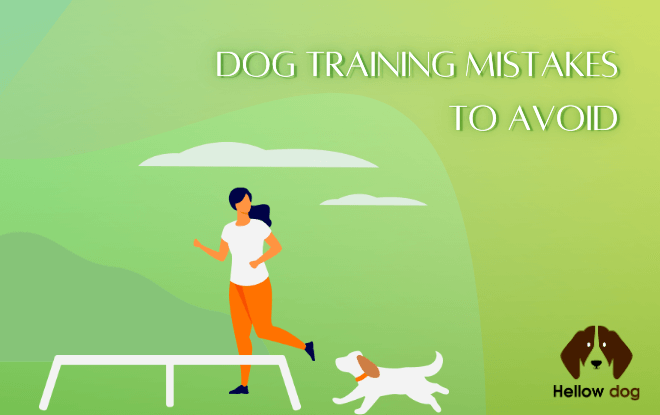Training a dog takes lots of work and patience. Often, dogs are similar to young children in that you may have to discipline them for them to learn a lesson. Sometimes, frustration with your dog’s behavior can lead to mistakes. When not corrected, these mistakes may affect the success of the dog training process. Often people wanted to give top dog training to their furry friends but they should know about the mistakes before starting.
Here are some of the top dog training mistakes that you should avoid:
Delaying the Training Session
One of the most common mistakes people make in dog training is waiting too long to start their training. Some would reason that they need to warm up to the dog first before training can begin. Ideally, training should start as soon as they arrive home with you. There’s no ideal age for your dogs to undergo training. The sooner you can enforce good behavior, the quicker and easier it becomes for them to learn and put it into practice, especially if you need them to become emotional support pets.
Engaging in Prolonged Training Sessions
You should be mindful of how long your training sessions are. Like people, dogs get tired too. They may get bored and refuse to pay attention to what you are trying to teach them. Ideally, your training session should last about 10 to 15 minutes, and that’s it.
Forcing the Dog to Learn
It is typical for a dog owner to repeat commands until the dog gets it. However, this is not effective for the dog, as they don’t receive any new information that they can use to learn the trick. If the dog doesn’t understand the command after three consecutive tries, then it is time to stop. Don’t force your dog to learn, or you could make them frustrated and stop trying altogether.
Training the Dog in a Bad Disposition
Never teach your dog if you are mad or angry. It is highly likely that you would end up punishing your dog if they make a mistake. If you are in a bad mood, use this time to cuddle with your dog until your mood improves. Dogs are great emotional support animals that you can rely on.
Sowing Confusion
When it comes to reinforcement methods, several studies have already shown that positive reinforcement is better than correction-based methods. However, trainers who mix the two will only sow confusion on how the dogs should behave. Your dog may be uncertain about what to expect, or if they’ll be punished or rewarded for an action. When this happens, your dog will refuse to cooperate with you.
Forgetting to Practice
Let’s say you’ve enrolled your dog in a behavioral class, and they’ve learned a trick or two. You have to ensure that you practice this learned behavior after the class is over, or their lack of practice may result in your dog forgetting its training. Practice new tricks and behaviors with your dog daily to keep their memory sharp.
Overindulging Them with Treats
While it is good to use positive reinforcement while training your dog, you must be careful not to overindulge them with treats. It’s important to remember that there are other methods to reward your dog for a job well done; by constantly giving them treats as rewards, you’re teaching them to rely on food for obedience. Aside from giving them treats, you can also pet them, give them a belly rub, or verbal affirmation to communicate that they’ve done well.
Repeating Cues
One of the most common mistakes dog owners make is nagging their dogs. If you keep repeating the command before your dog can take action, they may think that they don’t have to respond to your first cue. For example, if you say “come,” and they don’t go to you, don’t repeat it immediately. Have patience and make sure your dog hears your command properly and responds. If they don’t wait a moment before trying again.
Misusing Cues
Aside from repeating commands, most new dog trainers can misuse them as well. Try not to associate commands with activities the dog dislikes, as it could lead to confusion for the dog or disobedience. For example, you may have successfully taught your dog to follow when you say “come”, and then you subsequently use this command to get them to take a bath — an activity they dislike. When this happens, don’t be surprised if your dog doesn’t come to you the next time you use this command. For cases like these, try to have different commands for activities or actions your dog doesn’t like; regardless of their preference, it will help to establish a good basis for association.
Having One Venue for Training Sessions
If you always train your dog in the same place, they may only obey your commands in that place. If you want your dog to behave in whatever environment they are in, make sure to train them in different places in your home and outside. Expose your dogs to different areas so they learn that their behavior must not be confined to one place only.
Feeding Human Food
When your dog looks at you with those puppy dog eyes during dinner, it can be tempting to feed them food scraps, but this is something you should avoid. Not only will it affect their diet and nutrition, but it will also encourage them to ask for more food. This is not good dog training because it encourages bad behavior.
Assuming Your Dog Understands Your Language
Dogs need time to learn your cues and that goes the same for your language. No dog is born to understand English, so when you say “Come,” don’t expect your dog to drop whatever it is they’re doing to go to you. You need to be consistent with your training so it is easier for them to familiarize themselves with your cues and language.

Tips for Training Your Dog
- Start With the Basics
It can be exciting when you teach your dog complex tricks. While more advanced tasks are great for showing off, it’s best to start with basic commands before proceeding to more complex tasks.
- Have Patience and Set Your Expectations
Sure, you should start dog training as soon as possible, but you also have to understand that puppies are babies and your expectations should not be high. Give them time to get the hang of the training and before you know it, they’ll be getting the hang of all sorts of new tricks.
- Learn Your Dog’s Body Language
One of the first things you should do when training your dog is to look for visual cues that will let you see how you should approach them during the training process. For example, how do you interpret your dog’s tail wagging behavior? Contrary to popular belief, tail wagging is not always a signal of happiness in a dog. Oftentimes, it can mean that they are emotionally stimulated, and it can be a sign of frustration just as much as it can signal excitement. To start, you can look at the speed and direction of the wagging to gauge their emotions.
- Give High-Value Treats
If you provide your dog with high-value treats, you’d be surprised at how hard they’ll work to win them. Now and then, reward them with chicken breast, liver, or cheese. Dogs are remarkably food-driven creatures, and while they’re always happy with dog treats, more complicated tricks deserve better rewards. As training gets more difficult, high-value treats will help them learn that they get rewarded for a more complex task. One thing you should remember is that you also have to be quick when rewarding your dog with treats. Dogs will learn what we reinforce. When you give them treats immediately after performing a trick, they will associate the completion with food, which will make them more willing to do it again for you.
- Provide Enough Mental Stimulation
Dogs can get bored easily. If you keep them in a single program or have them perform the same trick for too long, they may lose interest. Provide them with proper mental stimulation as much as you can. For puppies, a well-founded mental exercise is enough to serve as a physical exercise. For older dogs, you may have to think of better options.
- Always Be Happy When Your Dog Comes to You
Whether you call your dog or not, always be happy when they come to you. This provides them with a positive outlook when their every interaction with you is met with praise.
Dog training can be fairly challenging if you don’t understand the temperament of your dog. As dogs are not of the same breed, they may respond differently to various training methods. However, the key to achieving a successful dog training program is consistency. You have to commit to the process and put your heart and mind into ensuring your dog learns proper behavior, especially if they are going to be used as service dogs.







